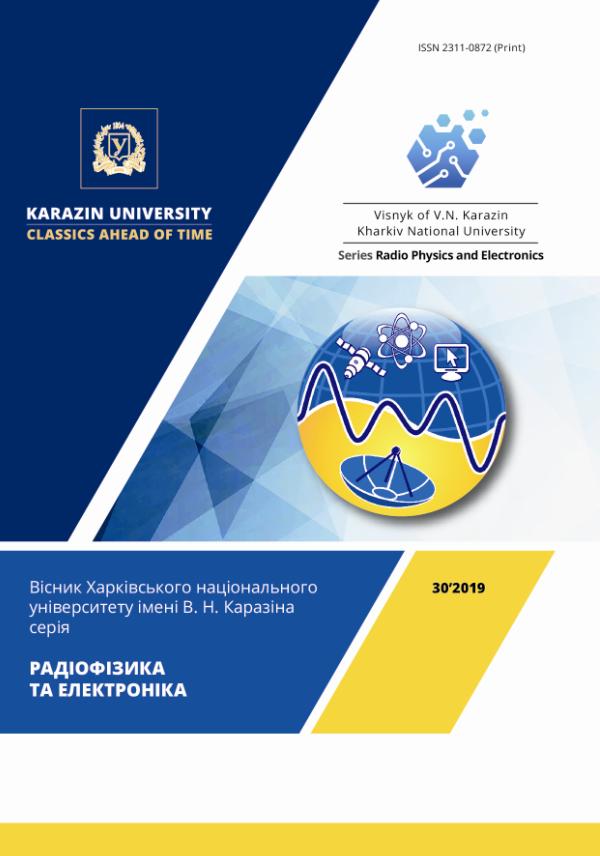Optimization of the method for exciting an inverted strip dielectric waveguide with metal plane
Abstract
Background. Currently, the application of various types of dielectric waveguides in the millimeter wavelength range is very promising, including metal-dielectric structures and functional units based on them. This is due to the simplicity and low cost of manufacturing dielectric waveguides and functional units based on them, the possibility of their integration with active elements, the use of various dielectrics and polymers having both a wide range of dielectric constants and a variety of mechanical properties (in particular, some dielectric materials have significant flexibility).Objectives. To optimize the method of excitation of one of its eigenwaves in a inverted strip dielectric waveguide with a metal plane through a series of physical experiments.Materials and methods. The studied electrodynamic structure belongs to the class of hybrid metal-dielectric structures. Its basis is a inverted strip dielectric waveguide with a metal plane. A feature of the used inverted strip dielectric waveguide is its composition: the main part of the waveguide rod adjacent to the metal plane is made of polystyrene, the second part is made of fluoroplastic. The evaluation of the excitation efficiency was carried out by the magnitude of the introduced attenuation into the tract. Using the method of a moving probe, the degree of concentration of the electromagnetic field near a complex compositional waveguiding rod was estimated. The fields were visualized using the contour method.Results. Based on a series of experimental studies, the method for exciting an inverted strip dielectric waveguide with a metal plane is optimized. The effect of optimal excitation was achieved through the use of the composite design of the dielectric waveguiding rod. With the optimal ratio of the material constants of the layers forming the waveguiding rod and the geometric parameters of these layers, it was possible to significantly expand the working frequency band, within which the level of insertion loss did not exceed the specified values. It was found that the electromagnetic field is concentrated mainly near the dielectric rod, providing a stable wave mode. It has been established that with a certain ratio of structure parameters, the frequency selection mode can be implemented in it. Conclusions. In the course of physical measurements, it was found that a inverted strip dielectric waveguide with a metal plane with the optimal choice of parameters is able to effectively maintain the wave mode with a low level of insertion loss. In general, a structure with a certain choice of parameters can operate in two regimes: waveguiding mode and frequency selection mode.
Downloads
References
Knox RM. Dielectric waveguide integrated circuit an overview. IEEE Trans. Microw. Theory and Tech. 1976 Nov;24(6):806-814.
Solbach K. E-Band leaky wave antenna using dielectric image line with etched radiating elements. IEEE – MTT–S International Microwave Symposium Digest; 1979 Apr 30-May 2; Orlando, FL, USA; 1979.
Vershinina LN, Meriakri VV. Dielektricheskii poloskovyi volnovod dlia korotkovolnovoi chasti millimetrovogo diapazona voln [Dielectric strip waveguide for the shortwave millimeter wavelength range]. Radiotekhnika i elektronika. 1980;25(7):1348-1351. [In Russian].
McLevige W, Itoh T, Mittra R. New waveguide structures for millimeter wave and optical integrated circuits. IEEE Trans. Microw. Theory and Tech. 1975 Oct;23(10):788-794.
Solbach K. The Fabrication of Dielectric Image Lines Using Casting Resins and Properties of the Lines in the Millimeter wave Range. IEEE Trans. Microw. Theory and Tech. 1976 Nov;24(11):879-881.
Crampagne R, Padellec L, Sarremejean A. Leaky wave antenna using an inverted strip dielectric waveguide. Proceedings of the 10th European Microwave Conference; 1980 Sept 8-12; Warszawa, Poland; 1980.
Rawat B, Dalmia M. Computer aided design of inverted strip dielectric waveguide millimeter wave ring-resonator and coupler. Int. Journal of Infrared and Millimeter Waves. 1984 Dec;5(12):1527-1542.
Itoh T. Inverted strip dielectric waveguide for millimetre-wave integrated circuits. IEEE Trans. Microw. Theory and Tech. 1976 Nov;24(11):821-827.
Mayboroda DV, Pogarsky SA, Saprykin II. The Radiating Unit Based on Hybrid Metal-Dielectric Structure with Bounded Sequence of Transverse Slots. Int. J. of Electromagnetics and Applications. 2012;2(6):159-162.
Mayboroda DV, Pogarsky SA, Saprykin II, Pshenichnaya SV. The radiator of Ku-band based on inverted dielectric waveguide. Proceedings of the International Conference on Ultrawideband and Ultrashort Impulse Signals; 2010; Sevastopil, Ukraine; 2010. p. 215–217.
Mayboroda DV, Pogarsky SA. A Leaky-wave antenna on the basis of an inverted dielectric waveguide. Telecommunications and Radio Engineering. 2018;77(10):853-862.
Maiboroda DV, Pogarskii SA, Smirnova EO. Izluchaiushchaia struktura na osnove invertirovannogo dielektricheskogo volnovoda s dopolnitelnymi elementami [Radiating structure based on an inverted dielectric waveguide with additional elements]. Vіsnik kharkіvskogo natcіonalnogo unіversitetu іmenі V.N. Karazіna, serіia «Radіofіzika ta elektronіka». 2018; 29:57-63. [In Russian].




